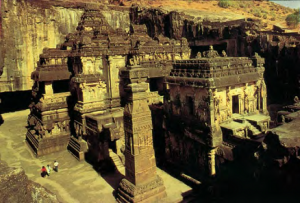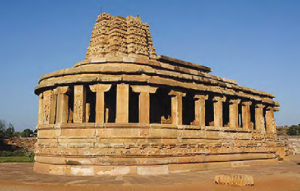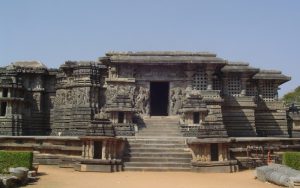TEMPLE ARCHITECTURE AND SCULPTURE
(2) The Dravida Or South Indian Temple Style
- Unlike the nagara temple, the Dravida temple is enclosed within a compound wall.
- The front wall has an entrance gateway in its centre, which is known as a gopuram.
- The shape of the main temple tower known as vimana
- In Tamil Nadu is like a stepped pyramid that rises up geometrically rather than the curving shikhara of North India.
- In the South Indian temple, the word ‘shikhara’ is used only for the crowning element at the top of the temple which is usually shaped like a small stupika or an octagonal cupola— this is equivalent to the amlak and kalasha of North Indian temples.
- The entrance to the North Indian temple’s garbhagriha, it would be usual to find images such as mithunas and the river goddesses, Ganga and Yamuna, in the south you will generally find sculptures of fierce dvarapalas or the door-keepers guarding the temple.
- It is common to find a large water reservoir, or a temple tank, enclosed within the complex.
- The North Indian idea of multiple shikharas rising together as a cluster was not popular in South India.
- Some of the most sacred temples in South India, the main temple in which the garbhagriha is situated has, in fact, one of the smallest towers. This is because it is usually the oldest part of the temple.
- Example in the Sriranganathar Temple at Srirangam, Tiruchirappally, there are 7 concentric rectangular enclosure walls each having gopurams. The tower at the centre has the garbhagriha.
- Famous temple towns of Tamil Nadu: Kanchipuram, Thanjavur (Tanjore), Madurai and Kumbakonam.
- In the 8th to 12th centuries – temples were not confined to being religious centres but became administrative centres as well with large swathes of land.
Subdivisions of Dravida
temples:
- Kuta or Caturasra: square-shaped
- Shala or Ayatasra: rectangular-shaped
- Gaja-prishta or vrittayata or elephant-backed: elliptical
- Vritta: circular
- Ashtasra: octagonal
Pallava Architecture
- The Pallavas were one of the ancient South Indian dynasties that were active in the Andhra region from the second century CE onwards and moved south to settle in Tamil Nadu.
- They built many monuments and temples during the 6th to the 8th centuries.
- Although they were mostly Shaivite, some Vaishnava monuments are also seen. Their architecture was also influenced by the Buddhist heritage of the Deccan.
- Their early buildings were rock-cut whereas the later were structural.
- The early buildings were built during the reign of Mahendravarman I, a contemporary of the Chalukya king Pulakeshin II of Karnataka.
- His son Narasimhavarman I, also known as Mamalla, was a great patron of the arts. Most buildings in Mahabalipuram (also called Mamallapuram in his honour) are attributed to him.
- In Mahabalipuram, there are exquisite monolithic rathas and mandapas. The five rathas are known as Panchapandava Rathas.
Dravidian Temple Architecture –
1 Shore Temple – Mahabalipuram
- The shore temple at Mahabalipuram was built later, probably in the reign of Narasimhavarman II
- known as Rajasimha who reigned from 700 to 728 CE.
- It has three shrines – one Shiva shrine facing east, one Shiva shrine facing west, a middle shrine to Vishnu in Anantashayana pose. The presence of three main shrines is unique.
- It is probable that the shrines were not all built at the same time but were added later.
- There is evidence of a water reservoir and a gopuram.
- There are sculptures of Nandi the bull (Shiva’s mount) along the walls of the temple. There are several carvings as well.
2 Brihadiswara Temple – Tanjore
- Shiva temple, also called Rajarajeswara Temple.
- Completed around 1009 AD. Built by Rajaraja Chola.
- It is the largest and tallest of all Indian temples. This Chola temple is bigger than any of the previous Pallava, Chalukya or Pandya structures.
- More than 100 temples of the Chola Period are preserved. A lot of temples were constructed during the Chola period.
- Its pyramidal multi-storied vimana is almost 70 metres high.
- There is a monolithic shikhara atop the vimana.
- The shikhara is a dome-shaped octagonal stupika. It has two large elaborately sculptured gopuras. On the shikhara, there are large Nandi images.
- The kalasha on top of the shikhara is 3m and 8cm tall.
- There are hundreds of stucco figures on the vimana. Many might have been added later on in the Maratha period.
- The main deity of Shiva is portrayed as a huge lingam set in a double-storied sanctum.
- The surrounding walls of the sanctum are adorned with painted murals and sculptures of mythological stories.
Architecture in the Deccan
- A hybridised style mixing elements from both Nagara and Dravida styles emerge as a distinct style during the middle of the 7th century in regions like Karnataka.
- This is referred to as Vesara in some ancient texts.
- Some of the temples are either completely nagara or dravida. Not all temples in the Deccan are in vesara style.
- Kailashnath Temple, Ellora
 Completely in Dravida style.
Completely in Dravida style.- Main deity is Lord Shiva.
- There is also a Nandi shrine.
- Vimana rises 30 m.
- This temple was carved out of a portion of a hill.
- The temple is grand and imposing.
- Built during the Rashtrakuta phase at Ellora.
Chalukya Architecture
- Western Chalukya kingdom was established by Pulakesin I when he took control of the land around Badami in 543 AD.
- Early western Chalukyas ruled the region till around the mid-8th century.
- Early activities are rock-cut caves while structural temples were built later on.
- Ravana Phadi cave at Aihole
- Important structure at this site: Nataraja
- This image is surrounded on the right by four large saptamatrikas and on the left by three large ones.
- The figures have slim, graceful bodies. They have long oval faces. They wear short pleated dhotis and tall cylindrical crowns.
- Distinct feature of Chalukya architecture: mixing and incorporation of several styles.
- Temples at Pattadakkal, Karnataka
- Pattadakkal is a UNESCO World Heritage Site.
- There are 10 temples. Four are in Dravida style, four are in Nagara style, one (Papanatha Temple) is a fusion of both and one is a Jain temple.
- Jain Narayana temple – built by Rashtrakutas in the 9th century.
- Virupaksha Temple – built by the chief queen of Chalukya king Vikramaditya II (733 – 44), Loka Mahadevi. Best example of Dravida style.
- Durga Temple, Aihole
 Apsidal shrine resembling a Buddhist Chaitya hall.
Apsidal shrine resembling a Buddhist Chaitya hall.- Surrounded by a veranda.
- Shikhara is like a nagara one.
- The Lad Khan temple at Aihole
 Located south of the Durga temple. Built in the 5th century.
Located south of the Durga temple. Built in the 5th century.- Inspired by the wooden-roofed temples of the hills, but is made out of stone.
- Built in the Panchayatana style.
- So named because a person named Lad Khan had used it as his residence for some time.
Hoysalas Temple Architecture
- Hoysalas grew into prominence in South India after the Chola and the Pandya power declined.
- Centred at Mysore.
- Chief temples are at Belur, Somnathapuram and Halebidu.
- These temples have a plan called the stellate plan. This is because the plan which emerged from being a straightforward square to a complex one with many projecting angles began to resemble a star.
- The star-like ground plan is a distinct feature of Hoysala architecture.
- Style is Vesara.
- Made of soapstone which is relatively soft. This enabled artists to carve intricate details like jewellery.
- Hoysaleshvara Temple, Halebid
 Made of dark schist stone in 1150.
Made of dark schist stone in 1150.- Dedicated to Nataraja (Shiva).
- It is a double building with a large hall for the mandapa.
- A Nandi pavilion is in front of each building.
- The temple’s tower fell a long time back. The structure of the temple is evident from the detailed miniature ones at the temple’s entrance.
- Very intricate and detailed carvings.
Vijayanagara Architecture
- City of Vijayanagara (City of victory) founded in 1336.
- Visited by international travellers like Niccolo di Conti, Domingo Paes, Duarte Barbosa, Abd, al-Razzaq, etc. who have given vivid accounts of the place.
- Synthesizes the Dravida style with Islamic styles of the neighbouring sultanates.
- The sculpture tries to recreate the Chola tradition but the foreign influence is also seen.



No comments:
Post a Comment